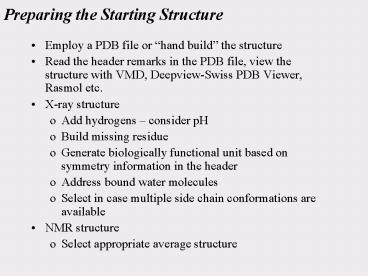Preparing the Starting Structure - PowerPoint PPT Presentation
1 / 19
Title:
Preparing the Starting Structure
Description:
Amber simulation : 0.5- 5.0 ps. Artifact: Hot solvent, sold solute ... Constraint implies absolutely fixed values for the selected dof (degree of ... – PowerPoint PPT presentation
Number of Views:69
Avg rating:3.0/5.0
Title: Preparing the Starting Structure
1
Preparing the Starting Structure
- Employ a PDB file or hand build the structure
- Read the header remarks in the PDB file, view the
structure with VMD, Deepview-Swiss PDB Viewer,
Rasmol etc. - X-ray structure
- Add hydrogens consider pH
- Build missing residue
- Generate biologically functional unit based on
symmetry information in the header - Address bound water molecules
- Select in case multiple side chain conformations
are available - NMR structure
- Select appropriate average structure
2
Generating the Input Structure
3
Sander Input File
4
Temperature Control
- To generate NVT, NPT ensembles
- To study the system behavior as temperature
changes - Protein unfolding
- Perform simulated annealing
- Searching conformational space
5
Constant Temperature Dynamics
- Kinetic Energy
- Velocity Reassignment Maxwell-Boltzmann
Distribution - Velocity Scaling
6
Constant Temperature Dynamics
- Berendsen Temperature Coupling Scheme
Rate of change of temperature is proportional to
the difference in temperature between bath and
the system ? a coupling parameter whose
magnitude determines how tightly the bath and
system are coupled
Amber simulation ? 0.5- 5.0 ps
- Artifact Hot solvent, sold solute
7
Constant Temperature Dynamics
- Stochastic collisions method Anderson et al.
- Randomly choose a particle and reassign its
velocities from a Maxwell-Boltzmann distribution - Trajectory Collection of mini microcanonical
simulations - Extended system method Nosé et al., Hoover et
al. - Thermal reservoir is part of the system,
represented by additional degrees of freedom - A fictitious mass parameter of the extra degree
of freedom controls energy flow between the
reservoir and system, larger the value of this
parameter, slower the energy flow
8
Constant Pressure Dynamics
- Isothermal-isobaric ensemble
- Pressure is related to virial product of
position and the derivative of PE - Pressure is maintained by volume fluctuations of
the simulation cell - Volume fluctuations is related to isothermal
compressibility, ?
9
Constant Pressure Dynamics
- Box side 20 Å (volume 8000 Å3) at 300 K
- For an ideal gas ? 1 atm-1, fluctuation 18100
Å3 - for water ? 44.75x10-6 atm-1, fluctuation 121
Å3
10
Constant Pressure Dynamics
- Weak Coupling method Berendsen
- Extended Pressure-Coupling method Anderson et
al. - Introduce an extra degree of freedom (piston)
corresponding to the volume of the box
11
Boundary Conditions
- Vacuum Boundary Condition
- Spherical Boundary Condition
- Periodic Boundary Condition
- Extended Wall Boundary Condition
12
Nonbonded Computations
- Minimum Image Convention
- ?(N2) Computational Problem
- Cutoff Schemes ?(N) Computation
- cutoff lt L/2 , neighbor list
- Lennard-Jones term converges early but not the
Coulomb term !
13
Particle Mesh Ewald
- A system of charged particles
- The charges are interpolated onto a grid
- Using FFT, the force and potential are calculated
at the grid points - Analytically differentiate the energies to
calculate the force and update coordinates
?(NlogN) Computation
14
Constraint vis-à-vis Restraint
- Constraint implies absolutely fixed values for
the selected dof (degree of freedom) of interest
during the simulation - Restraints means the use of a biasing energy
function to maintain the dof of interest close to
a reference state - The SHAKE procedure constraints the heavy atom
hydrogen bonds to a constant value so that the
simulation can focus on other more important low
frequency dof (implies we can use 2 fs timesteps
instead of 1 fs or lower) - The TIP3P water model constraints both the bond
lengths and H-O-H angle in the water molecule - The dof that can be placed under constrain or
restrain include both cartesian coordinates or
internal coordinates
15
Elements of MD Simulation
- Prepare the starting structure
- Parameters and topology
- Neutralize charge of the system
- Solvate
- Minimization
- Heating
- Equilibration
- Production
- Analysis
16
Following the Simulations Progress
Note Pressure fluctuations are higher than
temperature fluctuations!
17
Issues to Watch For!
- Imaging Simulation of infinite lattice under PBC
could cause molecules from the original box to
move out of the box. To obtain visually
appropriate structure, wrapping of the molecules
into the original box might be required. - Vacuum bubbles The way solute molecules are
soaked in water to obtain a solvated box causes
improper density of the system, hence constant
pressure simulations are required to properly
equilibrate the system. - Shake failures Common Causes bad steric
contacts, some atoms moving too fast, incorrect
potential being used?
18
Issues to Watch For!
- Hot solvent/Cold solute While employing uniform
pressure rescaling procedure, energy drain from
particular modes (eg. low freq modes of water)
could result in imbalances in atomic
temperatures. - Flying Ice Cube Related to uniform velocity
scaling procedures, with incomplete energy
conservation. Regularly remove COM motion during
the simulation.
19
Analysis of MD simulations
- Structural Properties
- RMSD
- Radius of gyration
- Temperature factors
- Distribution functions
- Energetic Properties
- Energy fluctuations
- Free Energy Studies
- Dynamical Properties
- Diffusion constants
- Time correlation functions
- PCA, QuasiHarmonic Analysis































